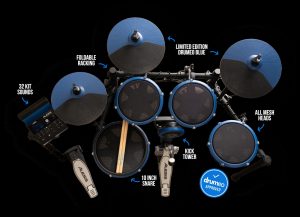Electronic drums can be even better when connected to your computer, whether it’s a Mac or a PC running Windows. You can do plenty of things by connecting your electronic drums to a computer, such as recording drum covers, replacing the built-in sounds with a VST drum library, or simply recording yourself using the built-in sounds.
What can I do with my electronic drums and my computer?
If your eDrums has a USB connection, it can be used as the sound card of your computer. That means you can route all your computer audio to your drum module and out through your headphone port or master out. Similarly, you can record the audio or MIDI from your drums on your computer with a DAW (Digital Audio Workstation) program.
How to connect eDrums to a computer
There are two types of connection you can use to connect electronic drums to your computer. Most electronic drums released in the last 10 years have a USB port, meaning you can connect to your computer with one lead. Older or lower-end electronic drums may only have a MIDI connector, which requires a USB MIDI interface to connect to a computer.
Below, we’ll look at a few different types of connections you might want to make using your electronic drums.
Connecting electronic drums to a Mac
If you have a Mac desktop or Macbook laptop, the easiest way to connect your electronic drums is via USB if your drums are equipped with it.
Electronic drums with USB typically use a USB 2.0 Type-B connector, which is typically found on devices like printers, scanners and desktop hard drive enclosures. If you have an older Mac with USB A sockets, then you can use a USB printer cable. These can often be found for under 4-8 dollars on Amazon.com or 3-7 pounds at Amazon.co.uk.
If you have a newer iMac or Macbook with USB-C sockets, then you’ll need a USB type-B to USB-C connector. Again, these can be had for cheap at Amazon.com or Amazon.co.uk.
Next, you’ll need to download the driver software for your electronic drums from the manufacturer. Once downloaded, open the file and install the software, plugging in your electronic drums if prompted.
Once complete, you’ll be able to assign your drum module as the sound output device on your Mac, enabling you to hear everything from your computer via your drum kit’s own audio outputs.
To record your drums, open a DAW program such as Garageband, Reaper or Logic Pro. Under the preferences menu, you can assign your Module as the audio in/out device and MIDI in device. You can then record audio or MIDI by assigning a track to the drum kit’s audio or MIDI channels and hit record.
Connecting electronic drums to a PC
The steps for connecting electronic drums to a PC is the same as for a Mac, only you’ll need to download driver software designed for Windows instead of the Mac version.
Again, you’ll need to use the right cables depending on what your computer has:
- USB Type-B to Type-A cables from Amazon.com or Amazon.co.uk
- USB Type-B to USB-C cables from Amazon.com or Amazon.co.uk
Then download and install the driver software, plugging in your drums if prompted.
Once complete, plug in your drums and turn them on. You’ll be able to assign them as your system output in the Windows system tray on your desktop, as well as being able to assign the audio and MIDI inputs to tracks in your DAW for recording.
Can Roland V-Drums be connected to a Mac?
Yes, Roland V-Drums work with Mac computers. Be sure to download the latest Mac driver for your particular drum module, which can be found on Roland’s Updates and Drivers page.
How to connect electronic drums to a computer using MIDI
If you have an older electronic kit that doesn’t have USB, you’ll need to use a MIDI connection. However, laptops and desktops don’t have built-in MIDI ports, so you’ll need to get a MIDI interface.
If you’re buying a new MIDI interface, it’s a good idea to avoid the very cheapest interfaces, as they tend to introduce excessive lag. If you want to use your eDrums to trigger a VST, lag is not great as you’ll hear each drum or cymbal after you’ve played it, making it almost impossible to keep time.
You can avoid this by buying from a reputable brand. I recommend the Roland UM-One, which I previously used on my old Roland HD1 electronic drum kit which had no USB port. This provided me with lag-free drumming using my MacBook Pro. You can pick up the UM-One MIDI interface at Amazon.com and Amazon.co.uk.
Another option is to go for a combined Audio/MIDI interface. This tends to be a better bet for PC users as it means you can avoid using the built-in computer audio to monitor your eDrum recordings, which are typically not designed for low latency.
The PreSonus Studio 24c is a popular choice, available in a range of bundles at Amazon.com and Amazon.co.uk, as well as in a few different versions with varying amounts of audio inputs.
How to connect my eDrums to Toontrack software
If you own EZdrummer or Superior Drummer from Toontrack, you can connect either of these VST drum libraries to your electronic drums to trigger amazing-sounding drum samples live or record studio-quality drums with your eKit.
Find out how to connect EZdrummer 3 to your eDrums, or how to use Superior Drummer 3 with eDrums.
This article contains affiliate links. If you purchase a product through certain links on our site, we may earn a small affiliate commission. Learn more about our adverts and why you can trust eDrumHub here.




